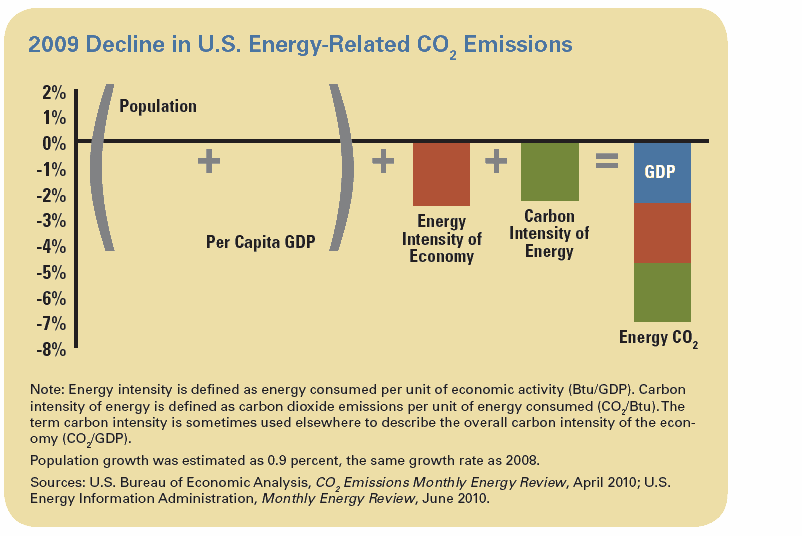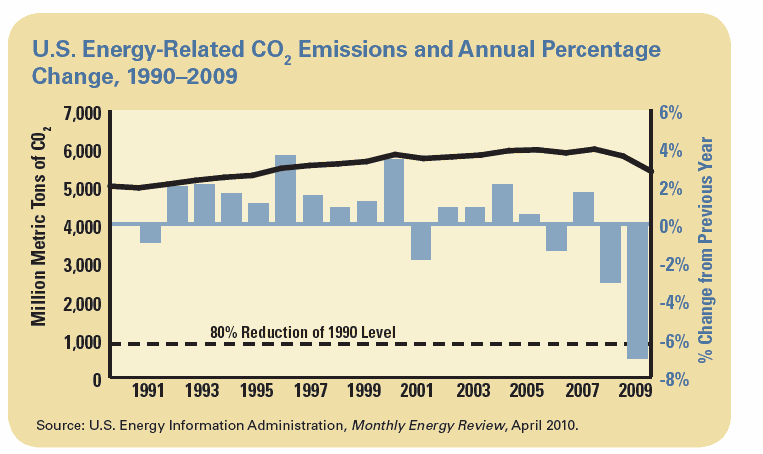URBAN LAND INSTITUTE
EXECUTIVE SUMMARY
The issue of energy efficiency reminds me of 30 years ago when somebody asked me to give the definition of affordable housing and there were 35 different definitions.
A Year without Precedent
In 2009, annual U.S. carbon dioxide emissions associated with energy consumption declined by an unprecedented 7 percent as a result of factors that included—but extended beyond— the economic recession, which represented a 2.4 percent decline in total gross domestic product (GDP). Two additional factors played a part in this reversal of a long-term trend of ever-increasing greenhouse gas (GHG) emissions: a decrease in the carbon content of primary fuels and, notably, the impact of investments in reducing the energy intensity of the economy. This report explores the latter factor—energy efficiency—in the context of the commercial building sector.
With broad economic recovery far from sight, many unknowns hang over the commercial real estate markets, feeding speculation about future market trends. Speculation is not limited to real estate markets. Environmental policy-making circles have seen the United Nations’ Copenhagen Summit and legislative initiatives in the U.S. Congress come and go without producing milestone frameworks for greenhouse gas reduction policies.
Meanwhile, the federal government has commenced a variety of executive branch initiatives aimed at reducing carbon emissions, which, while broad and far reaching, have not yet had significant impact on private commercial real estate markets. Local, state, and regional levels of government have been the platform where markets are being shaped to align intended environmental outcomes with economic development strategy. But today, the dominant regulatory forces shaping energy investments in real estate remain a lack of predictability and certainty in policy.
If you look at the reality of the market, there’s not a whole lot of demand for new buildings out there. That’s not going to be forever. But right now, if we want to change the game, we’ve got to focus on the existing building stock.
This report explores an issue that has risen to become one of the most immediate challenges for sustainable development: financing energy efficiency improvements in real estate. It also seeks to provide an overview of how emerging public policies combine to form a new backdrop for real estate investment.
More than 1,000 mayors in the United States— spanning every major real estate market in the country—have now made a pledge to reduce greenhouse gas emissions to 60 percent to 80 percent below 1990 levels. More than 35 governors have directed their staff to produce a climate change action plan. Cities and states have received dedicated U.S. Department of Energy (DOE) grants to transform existing energy efficiency strategies into market action with federal stimulus spending. Energy efficiency within existing buildings has placed real estate at the center of emerging climate change policies at all levels of government.
Selected highlights from this report include:
- A “New Normal” of Emissions Reduction? The impact of the market downturn on energy demand reduction is obvious. Less obvious is the downturn’s impact on consumer preferences and behavior, which is just beginning to be understood. While energy costs hover near historic lows, there is broad consensus that costs will bounce back higher as long-term demographic trends and booming emerging markets drive new demand. Detailed analysis of the variables behind last year’s unprecedented reduction in energy-related carbon emissions shows that it has resulted as a combined function of reduced energy demand, ongoing investments in energy efficiency, and investments in cleaner fuels. This meaningful two-year-old trend breaks the seeming inexorable historic rise of greenhouse gas emissions in the United States. Overall carbon emissions are now on par with the 1990 level, the United Nations benchmark from which an additional 60 to 80 percent reduction is targeted by 2050.The individual consumption and investment factors behind this reduction are undoubtedly complex, but may reflect the growing recognition of the economic and domestic risks associated with fossil fuel dependency. While media reporting and political rhetoric associate domestic energy use with economic and geopolitical uncertainty, it is the weakness of the short-term real estate markets that has put the spotlight on reducing building operating costs. Across the real estate industry a new mindset prevails, where the more one can manage to reduce energy use, the better. As quoted in the last year’s report, “measuring energy savings is like counting cash.”
- Energy Efficiency in Buildings: Investing in “Nothing.” Investors demand a return, but what if that return is “less” rather than “more”? Extensive technical analysis shows that chieving energy efficiency in buildings represents the lowest-cost path to short-term reductions of energy use and greenhouse gas emissions. Yet, popular mindsets and energy policy frameworks often favor supplyside investments in renewable or “clean energy” strategies, i.e., strategies that “produce something.” Elevating energy efficiency incentives to be on par with incentives for wind, solar, and other clean fuels continues to be among the most significant opportunities to catalyze market investment in producing new and retrofitted high-performance buildings. While investing in “nothing”—that is, an investment in consuming less—does produce a reduction in the operating costs in buildings, several market barriers must be overcome to produce the targeted 80 percent reduction in building energy use that DOE has set for all existing buildings by 2050.
We need the same kind of incentives as solar and wind, but we don’t have it.
- Climate Change Policy, Energy Policy, or Real Estate Investment Policy? Recent efforts to catalyze investments in retrofitting existing buildings have challenged how policy makers and market participants view real estate finance and valuation practices. Are investments in energy efficiency within existing buildings to be approached as a discrete value, capable of being financed independently of the underlying real estate asset and then traded as “efficiency-backed” securities on secondary markets? Or is an energy efficiency investment more like upgrading a lobby or installing granite countertops in a kitchen, whereby the investment enhances the underlying value of the underlying real estate asset? The answer is emerging to be both, as policy makers work on both sides of energy demand and supply.
After 25 years of making incremental efficiency improvements, we know that our tenant churn is less, our occupancy beats the market, our energy costs are lower, and our net operating income is higher than our competition.
- Transparency Mitigates Uncertainty. Market innovation requires new evidence or new guarantees of real costs and real investment returns. Although all market participants broadly acknowledge the value that energy efficiency represents, the standardized practices necessary to integrate that value into individual market transactions continues to support a gap between market reality and possibility. The challenge in financing energy efficient retrofits of existing buildings lies in generating objective, accessible, peer-reviewed information for the tools, technologies, and full costs associated with the energy savings over specific payback periods.
One of the ways we’re going to build back real estate value is by bringing back a strong bottom line by bringing operating osts down and really doing our knitting correctly.
- Lease-by-Lease Market Transformation. Many factors taken together make the business case for green retrofits of the existing building stock, not the least of which is tenant demand for such space. New building codes, growing investor demand, and the need to drive savings to the bottom line of operational expenses all contribute as well. All these factors and many more are playing a part in the transformation of the marketplace.
Step one is that tenants need to care about where they work and where they live. We need to look at sustainability holistically.
- Marching Orders for the Nation’s Largest Real Estate Portfolio. With an annual energy budget of $24.5 billion and an annual purchasing budget exceeding $500 billion, President Obama issues an executive order in January 2010 that the federal government will reduce its greenhouse gas pollution by 28 percent by 2020. By September, all federal agencies submitted plans to the White House on how they will achieve this goal, with the General Services Administration—the government’s real estate specialist, whose carbon footprint resides largely in more than 8,300 existing buildings—submitting its plan to exceed the president’s target. Other large corporations and institutional real estate owners have similar plans, creating a dynamic of top-down directive within segments of the marketplace.
Download full version (PDF): Climate Change, Land Use and Energy 2010
…
All first-person quotations in this publication were made by participants at the Urban Land Institute’s policy
and practice forum titled Energy Finance in Real Estate, held June 8, 2010, in New York City. In keeping with
ULI practice for such events, the Urban Land Institute has not attributed these quotations to individuals.
About Urban Land Institute
www.uli.org
“The mission of the Urban Land Institute (ULI) is to provide leadership in the responsible use of land and in creating and sustaining thriving communities worldwide. Founded in 1936, the institute now has more than 40,000 members worldwide representing the entire spectrum of land use and real estate development disciplines, working in private enterprise and public service.”
Tags: CO2, Emissions, Pollution, Real Estate, Solar Energy, ULI, Urban land Institute, Wind Energy








 RSS Feed
RSS Feed